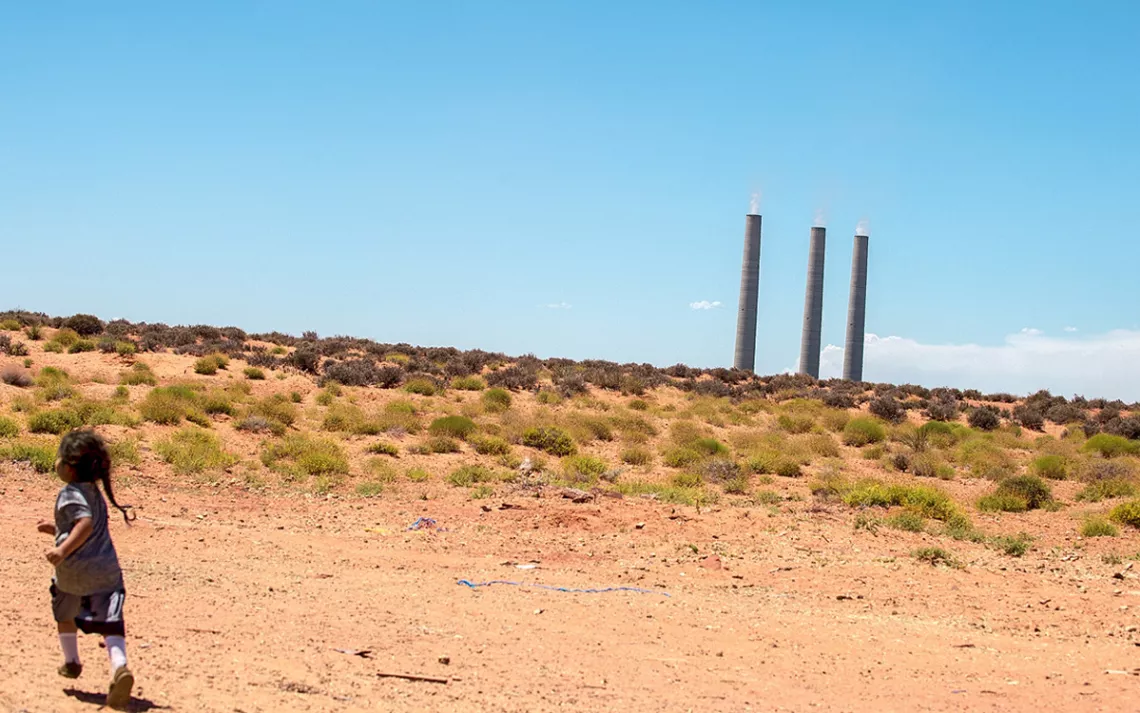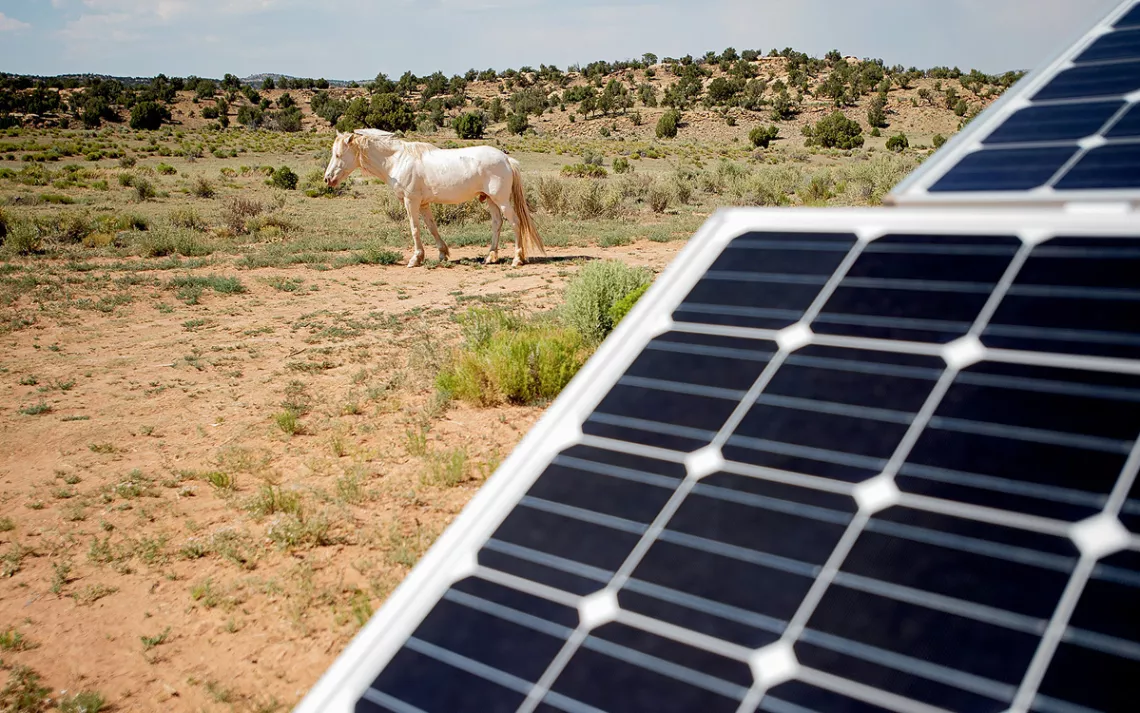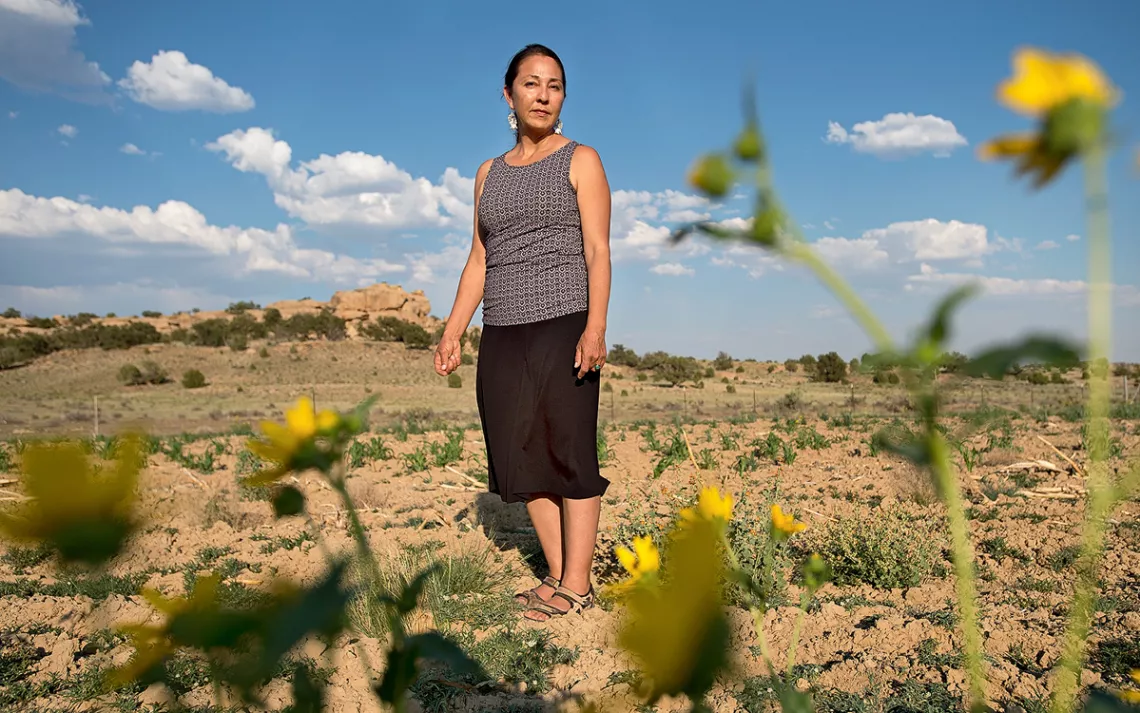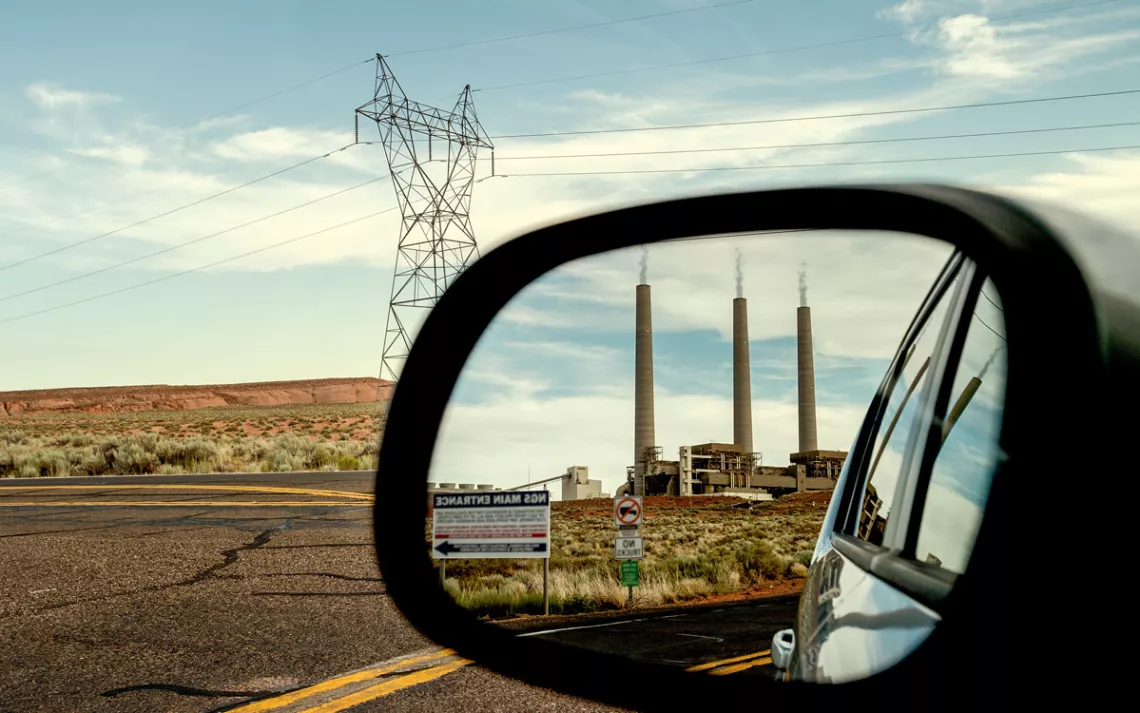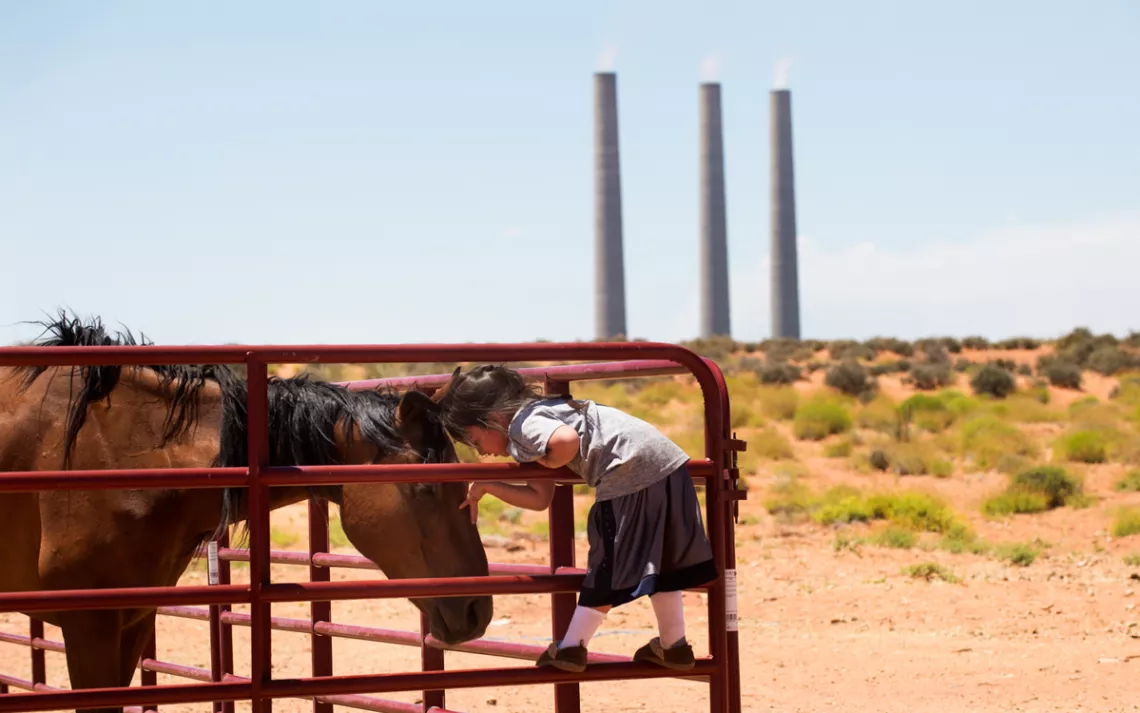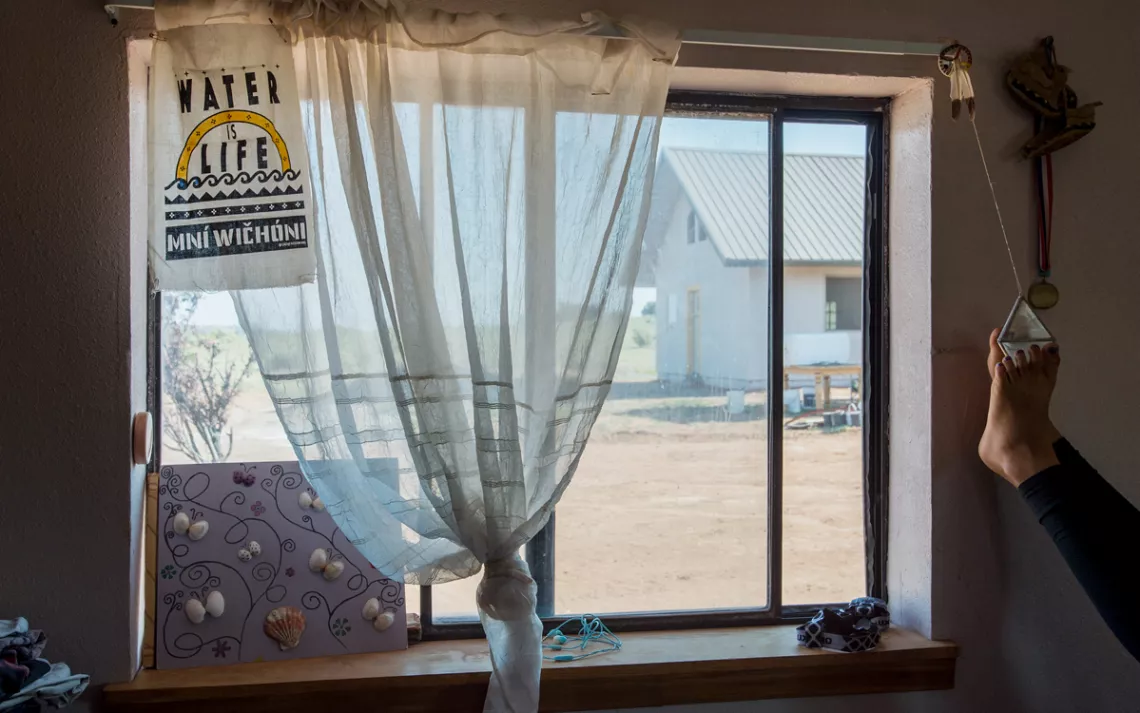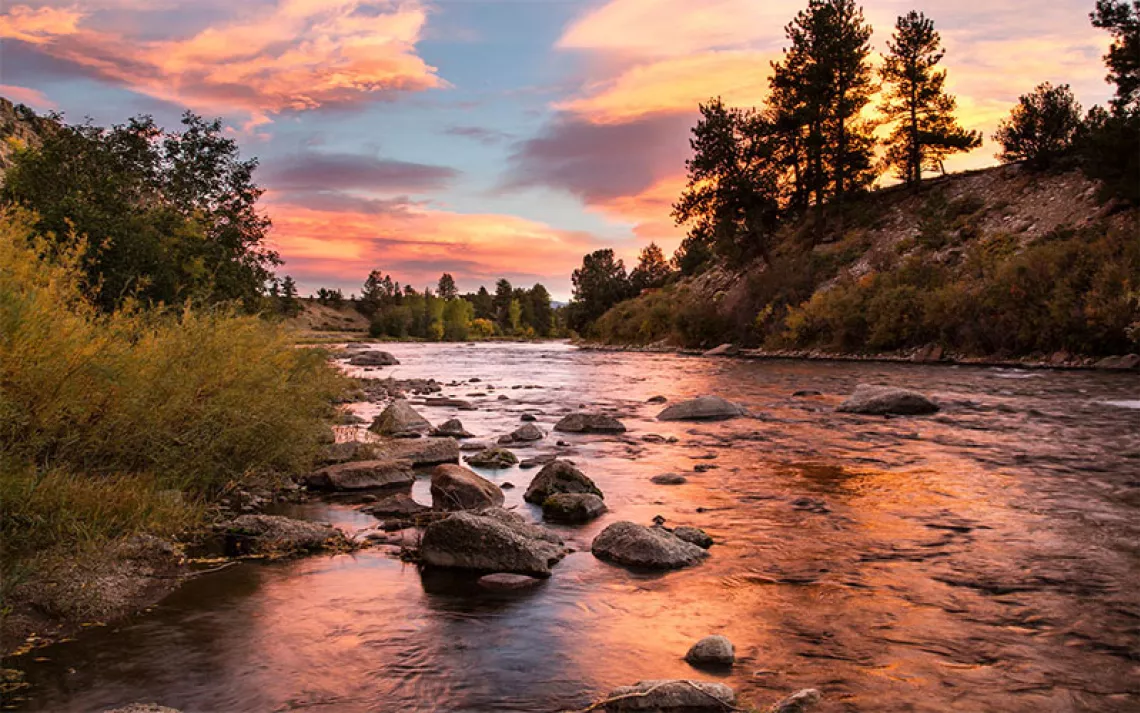The Largest Coal-Fired Power Plant in the West Is Slated for Closure
Navajo and Hopi communities are torn over the impending closure of a coal plant that brings both jobs and pollution
IT WAS STILL SPRING WHEN THE WATER became scarce on Black Mesa this year, an early heat wave to blame. The raging sun drove the sheep and cows to drink all day, tapping out the rain barrels. The ground withered; by mid-June, the earth was as cracked as raku pottery. Surveying the stunted piñon trees and scrawny sagebrush surrounding his homestead, Percy Deal knew what was coming: another hotter-than-ever summer.
"It never used to get so hot," said Deal, who has lived his whole life, 68 years, on this ginger-colored plateau on the northern edge of the Navajo Nation, the 27,000-square-mile indigenous territory that stretches across parts of Arizona, New Mexico, and Utah. The mercury had hit 108°F and was still rising; the heat wave would end up shattering records across the Southwest, grounding planes in Phoenix and contributing to at least 12 deaths from heatstroke. Still, Deal was preparing for an afternoon of heavy lifting. He needed water, and that meant loading up his half-ton truck with 55-gallon barrels and plodding 17 miles on a rutted, rocky road to his community well. Such public wells (a penny a gallon, plus a 4 percent tax) make it possible for people to live on Black Mesa with no other water source but rain and snow.
Until a few decades ago, the families on Black Mesa never had to trek to community wells or wait in line for up to two hours for water during the summer months. They had their own water, clean and abundant, from seeps and springs fed by the Navajo Aquifer. The aquifer afforded the Navajos and their neighbors, the Hopis, the means to live off the land for hundreds of years, thousands of years in the case of the Hopis. Deal was raised on the same land, and in more or less the same traditional manner, as his mother and her mother and her mother, going back at least six generations. The family raised sheep and cows, hunted deer and elk, and grew beans, corn, and squash, storing their harvests in underground cellars. Deal remembers herding 500 head of sheep as a teenager, when water from artesian springs seeped from the earth.
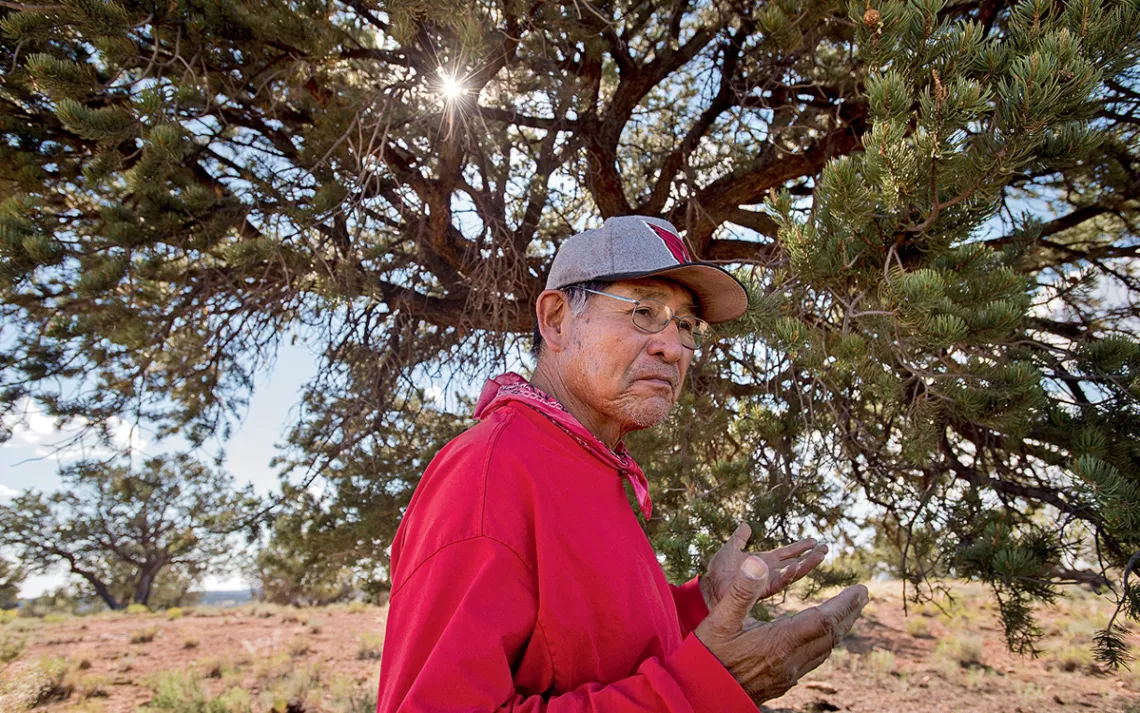
Percy Deal, 68, has been fighting the coal industry all of his adult life.
Then, in the late 1960s, Peabody Energy (today the largest coal-mining company in the United States) started to mine Black Mesa's vast coal deposits. In the process, the company began using billions of gallons of the Navajo Aquifer's water—as much as 3 million gallons a day—to move the coal via a slurry pipeline to the Mohave Generating Station, outside Laughlin, Nevada. The aquifer started to draw down.
Deal began noticing changes in the land and water in the mid-1970s. By the late 1990s, no one he knew on Black Mesa had enough water. Antelope, elk, bears, eagles—all important to Navajo and Hopi life—became rare. Deer herds diminished. The grasses that fed the sheep and cows shriveled. Families began considering the unthinkable: selling off their herds, leaving. Deal's quest to find answers fueled a career in politics (he recently retired after 27 years as a Navajo County commissioner) and made him a prominent voice in the grassroots movement to monitor the coal business on the reservation.
"Everything was clean and plentiful," he said, "especially the water, until Peabody decided to come in and change everything."
Now, things are poised to change again as the coal mining and the coal-fired energy production on and around Black Mesa are winding down. In 2005, the Mohave Generating Station closed, and with it one of Peabody's two mines: the Black Mesa Mine. The Navajo Generating Station (or, as locals call it, the NGS), a 2,250-megawatt coal plant on Navajo land that is the largest coal-fired power plant west of the Mississippi River, is set to shut down as early as 2019. Since the NGS is the sole customer of Peabody's Kayenta Mine on Black Mesa, that, too, is supposed to close—unless the tribes can find a way to ship coal outside the region, which many industry analysts consider highly unlikely.
For Deal and many other Navajo tribal members, the end of coal mining on Black Mesa feels like freedom after a long, wrongful prison sentence. "We have an opportunity to rebuild the Navajo Nation into a far more sustainable and equitable community," he said. "And we want the restoration of all that was, [of all] that can be, restored."
But other Navajos, including the tribal leadership, have a different take. Although the EPA has said that the Navajo Generating Station is among the worst polluters in the country in terms of CO2 and nitrous oxide emissions, the tribal government views it as a lifeline. The Navajo Nation and the Hopi Nation—a smaller tribe whose territory is surrounded by the Navajo reservation like the hole within a doughnut—rely heavily on Black Mesa coal. Between 30 and 40 percent of the Navajos' annual budget (and as much as 80 percent of the Hopis' in some years) comes from the lease payments and other revenue generated by the NGS and the Kayenta Mine. Together, the power plant and the mine employ some 750 people—providing the kind of high-paying jobs that don't come easy in the area.
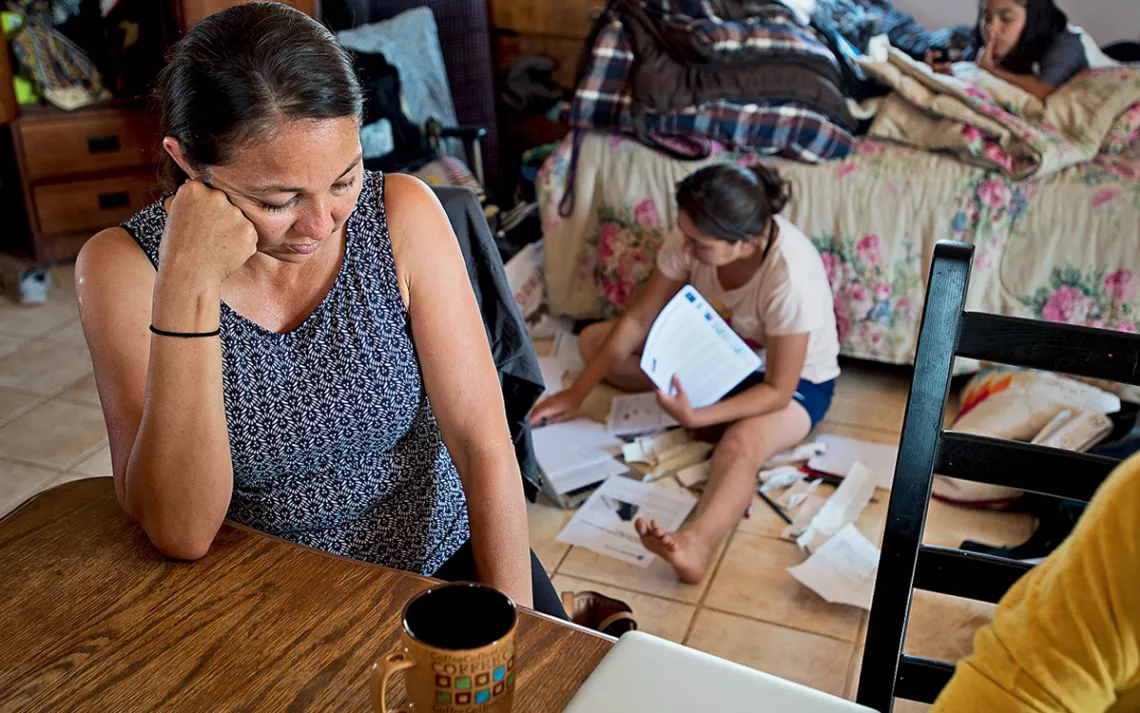
Nicole Horseherder and her daughters, Jessica and Mikayla, spend much of their time engaged in anti-coal activism.
"The nation must now look at how to transition itself," said LoRenzo Bates, the Navajo Nation Council speaker, who has worked forcefully to keep the NGS from closing. "But to what extent is the nation going to be able to make up $45 million?"
The paradox of coal mining and burning on the Navajo Nation isn't all that dissimilar to what other impoverished communities across the United States are struggling with: Communities acquiesce to harmful industries because they are desperate for money and jobs, then become reliant on those industries and eventually find it difficult, if not impossible, to break away and chart a new economic course, as reliance has turned into dependence. The Navajos are in a predicament like the one facing Appalachian coal towns and the oil and gas counties of the Dakotas: They're damned if they stick with the status quo, damned if they don't.
COAL MINING CAME TO BLACK MESA, a 5,400-square-mile plateau shaped like a bear's paw, as part of a grand plan devised by the state of Arizona and Congress in the late 1960s to support the growth of water-scarce central and southern Arizona. To meet the water demands of the state's burgeoning population, they dreamed up an engineering marvel: the Central Arizona Project, a 336-mile network of canals and pumps to lift water from the Colorado River more than 3,000 vertical feet, up and over three mountain ranges, to supply Phoenix and Tucson. To move all of that water would require power, lots of it. Coal fit the bill.
Peabody began its massive stripmining operation on Black Mesa with two dedicated clients, the NGS and the Mohave Generating Station. From the start, the coal plants were an amalgamation of public and private interests. While the Mohave plant was owned and operated by utility company Southern California Edison, the U.S. Bureau of Reclamation owns a quarter of the NGS, with the remaining interests held by Nevada utility NV Energy and Arizona utilities including the Salt River Project and Arizona Public Service. Although much of the power generated by the plants went toward the massive water diversion, the operations also provided electricity to cities all over the Southwest.
Fifty years later, the NGS has fulfilled the original vision behind its creation: Phoenix, Tucson, and Las Vegas have become desert metropolises. The benefits to the native nations are less clear.
The Navajo Nation—300,000 members strong, with some 175,000 members spread out across the reservation—remains poor, its unemployment rate somewhere between 40 and 50 percent. The Hopi Nation—12 villages situated on three mesas—is even poorer. Both reservations still lack running water and electricity for about 40 percent of the population. A generous explanation for that exclusion is that the costs of connecting remote communities to the power and water systems have always been too prohibitive. In another telling, people remain cut off from basic services because the federal agencies and utility companies have never considered tribal services as important as getting electricity to the suburbs of Las Vegas.
If the benefits for the native nations are mixed—full tribal coffers and jobs for some tribal members, even amid entrenched poverty—the costs are clear-cut. Perhaps the greatest injustice associated with the mines and power plants was the forced removal of 12,000 Navajos from a landscape the size of Rhode Island to make way for mining. A well-connected Utah attorney named John Boyden (who at the time was on the payroll of Peabody Coal) helped orchestrate the 1974 Navajo-Hopi Land Settlement Act, claiming it was about tribal land rights for the Hopis, when the goal was to have the federal government pay for the evictions. Many Navajo tribal members were "settled" in cheap public housing on a uranium-waste-contaminated site near Chambers, Arizona, more than a hundred miles away from their longtime homes.
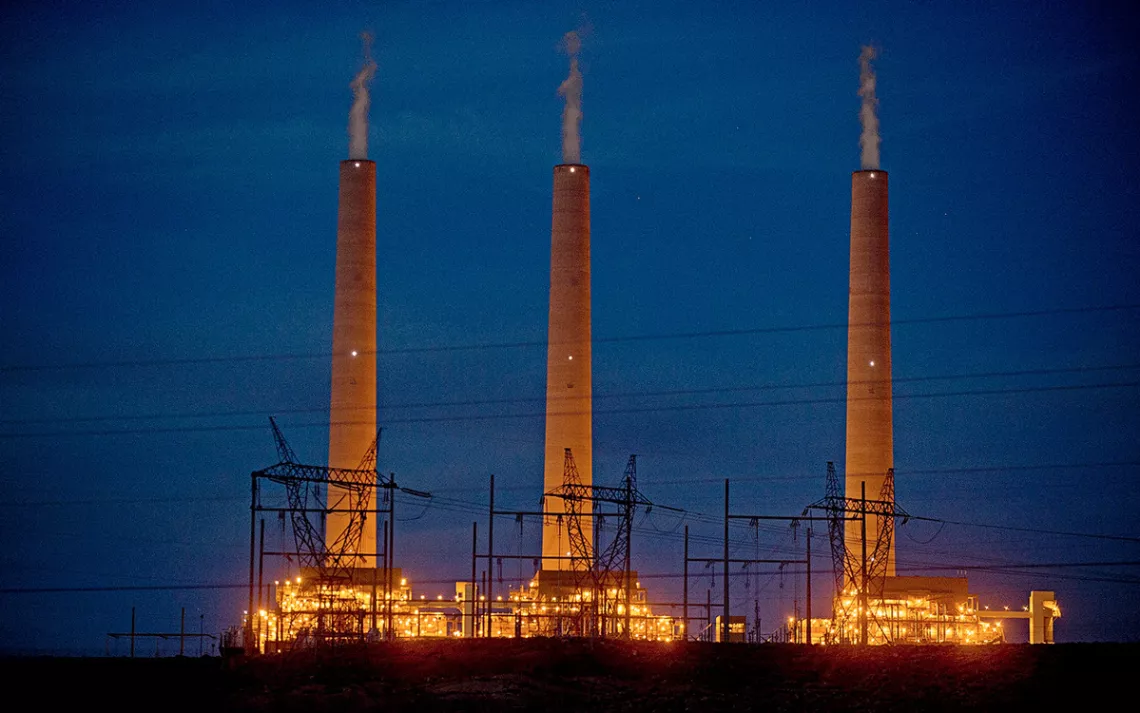
The Navajo Generating Station at night
Much of the coal operations' legacy is up in the air, literally. Like any coal plant, the NGS spews tons of the worst air pollutant (carbon dioxide), carcinogens (nickel, chromium), and the most dangerous neurotoxins (mercury, lead). The Clean Air Task Force, a nongovernmental organization, has estimated that pollution from the NGS contributes to 16 premature deaths, 25 heart attacks, 300 asthma attacks, and 15 asthma-related emergency-room visits each year, with annual health costs of more than $127 million.
Other costs of the local coal apparatus have yet to be documented. No studies exist on the prevalence of black lung among Navajo and Hopi miners. The practice of dumping coal waste in unlined open pits is loosely regulated (over the objections of environmental groups, the EPA doesn't consider coal ash and other coal products to be hazardous waste), and the long-term effects are unknown. While the water-scarcity hardships endured by Black Mesa residents are undeniable, the damage to the Navajo Aquifer is unclear. For many years, the Office of Surface Mining allowed Peabody to chart the impacts of its operations with only computer models, without monitoring what was really happening underground.
In 35 years, Peabody used 45 billion gallons of Navajo Aquifer water, drawing on water dated between 10,000 and 35,000 years old. The company's officials have refuted independent geological studies and blamed the draining of wells on a "20-year drought." Peabody did not respond to Sierra's requests to comment for this story.
At this point, it's premature to begin writing the obituary of the Navajo Generating Station. But this much is clear: The leaderships of the Navajo and Hopi Nations have sacrificed their people's air, water, land, and public health—in short, everything—for jobs and money from the coal operations. Eventually, regardless of when the plant and mine close, they'll lose those, too.
PERCY DEAL HAS BEEN FIGHTING the coal industry for all of his adult life. His campaigning against the mines and power plants began in 1973, just a few years after he returned to the reservation, having earned a degree from Northern Arizona University. Deal's first political battle—which he waged as a 23-year-old elected representative of his local community, or chapter—was fought against the federal government's relocation of Navajos to make way for the strip mines. Soon enough, he was agitating against the huge water withdrawals required for Peabody's 273-mile-long coal slurry line. (Though that line was shut down along with the Mohave Generating Station, Peabody still uses an estimated 1 million gallons of Navajo Aquifer water daily to wash the coal it ships from the Kayenta Mine to the NGS.)
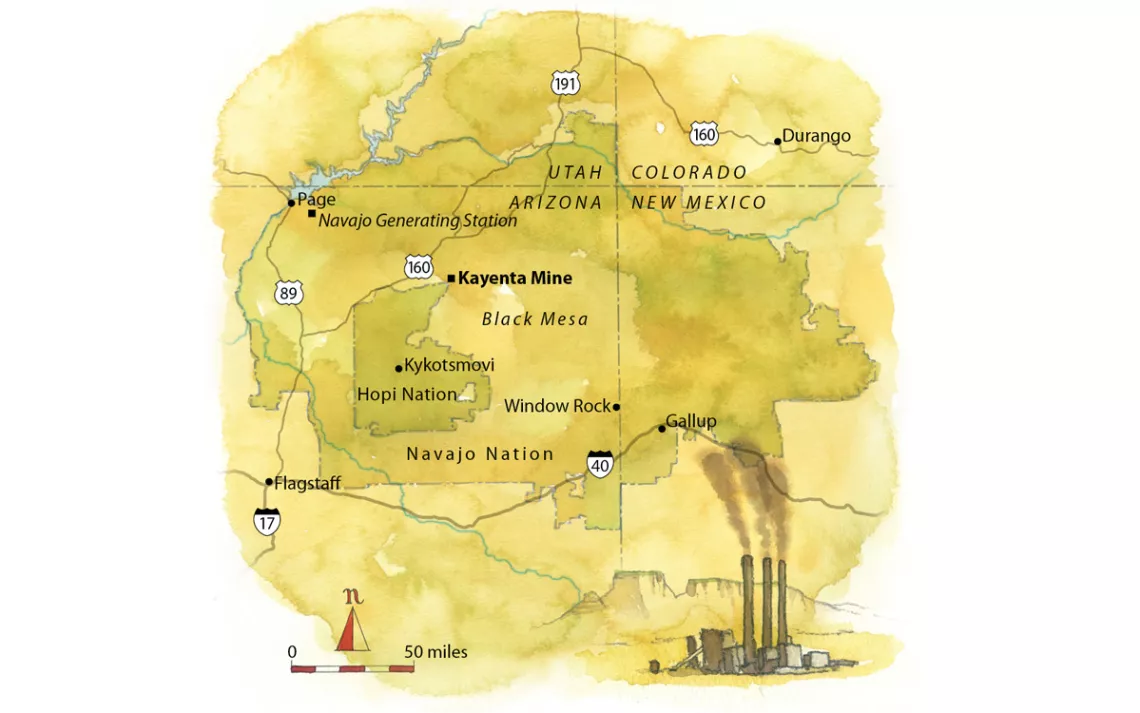
Map by Steve Stankiewicz
Deal has engaged in countless political fights since then, including an ongoing campaign for answers regarding the effects of the NGS and the mines on life—all life, from human to plant—on the tribal lands. Now, he said, the tribe can begin to evaluate the coal industry's legacy on Black Mesa, fix what can be fixed, and find alternatives to leasing tribal land to some of the most toxic industries on the planet.
Deal belongs to one of the first generations of Black Mesa warriors—today he's known as an elder—but there are plenty of others, Hopis and Navajos, who have spent years, decades, of their lives trying to stop coal. Nicole Horseherder, 47, and her husband, Marshall Johnson, 55, both from traditional Black Mesa families, have been partisans in the coal fight for nearly 20 years. The youngest three of their four children have never known a time when their parents were not wrapped up in efforts against Peabody, the power plant operators, and the tribal leadership. All of the kids at some point have been enlisted in the Horseherders' activism, from making posters to handling the paperwork for their parents' nonprofit, To'Nizhoni Ani (Navajo for "beautiful water speaks").
The Horseherder family lives miles from a paved road, off the grid, at the upper reaches of Black Mesa, more than 6,500 feet above sea level. Nicole works as a legislative aide to her local tribal council representative. In a typical week, she travels hundreds of miles to help tribal members, including elders who speak only Navajo. "I live here," she said, by way of explaining her commitment to anti-coal activism. "I drink the water."
A mile from the three towering smokestacks of the NGS, Derrick Young, 38, lives with his grandmother in a house with no running water. Much of his grandmother's land was taken before Young was born to make way for the electric railroad that transports coal from Black Mesa. The family had been on the land, which overlooks the spectacular cliffs of Monument Valley, for hundreds of years, since long before the nearby city of Page, Arizona, existed.
When the family's land was confiscated, they were promised compensation and jobs. "But my family got nothing from coal," Young said, glaring at the three 775-foot silos spewing smoke in front of him. A hot wind kicked up clouds of red dirt. "Oh," he said, "we did get coal dust."
Even though many Navajos (some publicly, others privately) welcome the end of the NGS era, like any breakup of a long-term relationship, the situation is complicated.
At least in the short term, tribal leaders say, the native nations' budgets will take a beating, social programs on the reservation will have to be cut, and people will suffer. When the NGS's operator, the Salt River Project, announced in February that it would be closing the plant to transition to cheaper gas plants elsewhere, the Navajo leadership was caught by surprise. (The other part owners of the plant had already given notice that they no longer found the operation profitable; NV Energy, for example, must pull out of the coal plant by 2019 under a law passed by the Nevada legislature.) Tribal officials had believed that they would have at least a couple of decades to figure out their post-coal future. In 2012 and 2013, they had spent a harrowing 12 months negotiating a lease extension that they'd believed would keep the plant, and the Kayenta Mine, operating until 2044.
As soon as it became clear that the Salt River Project was ready to decommission the plant, Navajo officials began scrambling. Eventually, they came up with a two-year extension that buys them some time to figure out the impending revenue shortfall. As this story was going to press, the Navajo government was still looking for a buyer for the aging coal plant. Russell Begaye, the Navajo Nation president, has complained that, despite Donald Trump's promise to "bring back coal," the U.S. president has done nothing to save the NGS.
Any NGS buyer would be slogging against the tide. Despite Trump's promises, the coal industry remains in a long-term decline. This is as true in Indian Country as it is in the United States as a whole. According to the Energy Information Administration, coal sales from native territories dropped by 37 percent between 2003 and 2014. The EIA projects that by 2040, U.S. coal production will be half of what it was in 2008. Also, the NGS is a fixer-upper; the plant needs at least $100 million in upgrades.
Even without the prospect of a buyer for the NGS, some Navajo elected officials aren't yet ready to give up on what has long been a kind of black gold. Bates, the Navajo Nation Council speaker, still retains his optimism about the economic potential of a coal-based economy. Bates has been the main political force behind efforts to keep the power plant and mine open. "You move away from the industry," he said, by way of warning against an NGS closure, "and to get back into that industry once opportunity presents itself will be very, very expensive."
Bates's answer? The Navajo Nation needs to explore new ways to produce and market coal. The latest lease with the NGS calls for the Navajo Nation to keep its infrastructure—an estimated $241 million worth of production equipment, including transmission lines and the electric railroad that brings enough coal from the Kayenta Mine to power half a million homes in the Southwest every day. Bates says that the nation should appreciate that it is sitting on one of the world's richest deposits of coal—and that should be worth something. Other uses for coal will be invented, he insists, and others are emerging. "At some point in time, we can look at coal becoming a resource that could be used other than for generating electricity."
The Black Mesa water protectors complain that Bates's rhetoric doesn't acknowledge the damages that coal has already done to the Navajo lands. "All I ever hear from the tribal council is 'jobs and revenue,'" Deal said. "When is the council going to start investigating the damages to our water, air, and health?"
OWING LARGELY TO THEIR tribal leaderships' long-standing alliance with industry, Hopi and Navajo grassroots activists can point to precious few victories over the coal companies. (The Mohave Generating Station was shuttered after noise and lawsuits from national environmental groups, including the Sierra Club, that challenged the flagrant pollution violations and the impacts of the slurry pipeline.) Now that the NGS is on the verge of closing—probably, that is—tribal activists see an unprecedented opportunity to take stock and find a path to an energy future that respects their traditional values. The aspirations of those like councilmember Bates, who envision some kind of future for coal, are delusions, Deal says. "If they are planning to do [coal] gasification, we will fight them every step of the way."
Nicole Horseherder's family is in it for the long haul as well. Even as they organize tribal members to oppose the coal industry, they are engaged in a kind of prefigurative politics—living the life they want to create for others. The Horseherders' home is powered by solar panels, and they keep a large vegetable garden with the traditional triumvirate of corn, squash, and beans.
"Staying on one's land is so important," Horseherder said, "especially for the womanfolk. Maintaining your ancestral land makes you aware that your livelihood is directly connected to the land your grandfolks worked on and lived on. Continuing farms and herding sheep is a continuation of the life as was set in motion by your ancestors."
She and her husband have no plans to leave. "Without heritage lands, the knowledge, practices, livelihood, and so forth is lost," she said. "Land is our connection to life. It tells us how to live. It tells us where to plant, where to graze sheep, where to hunt, where to gather medicine, and so forth. It is our mother, grandmother, great-grandmother. It nurtures and it whips. In old age, it cradles you and takes you back when you release your last breath. It plants grass over your grave and reminds you life goes on and you are merely a part of the earth and the cycle of life."
This article appeared in the November/December 2017 edition with the headline "Left in the Dust."
WHAT YOU CAN DO
To get involved in the Sierra Club's national campaign to transition away from coal-fired electricity, visit beyondcoal.org.
MORE
Before the Sierra Club was against the Navajo Generating Station, in the 1960s the organization was in favor of it. Read about the twisted saga: sc.org/ngsbackstory.
 The Magazine of The Sierra Club
The Magazine of The Sierra Club
